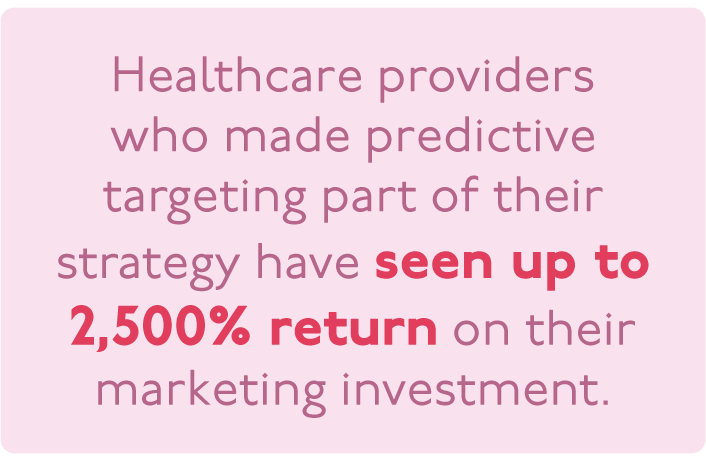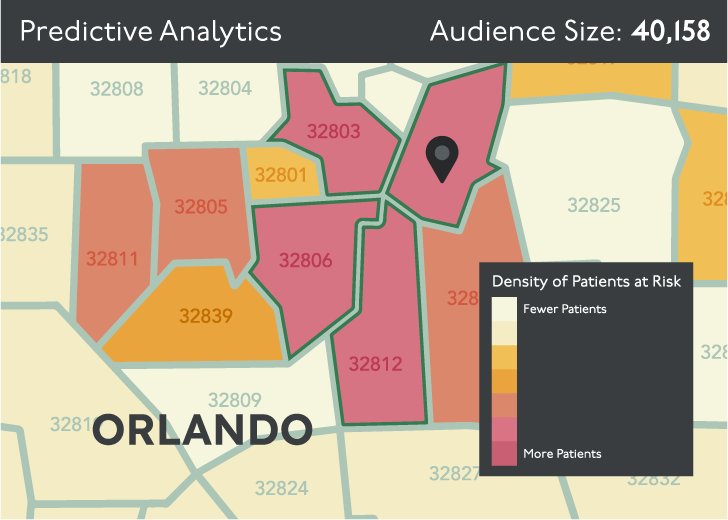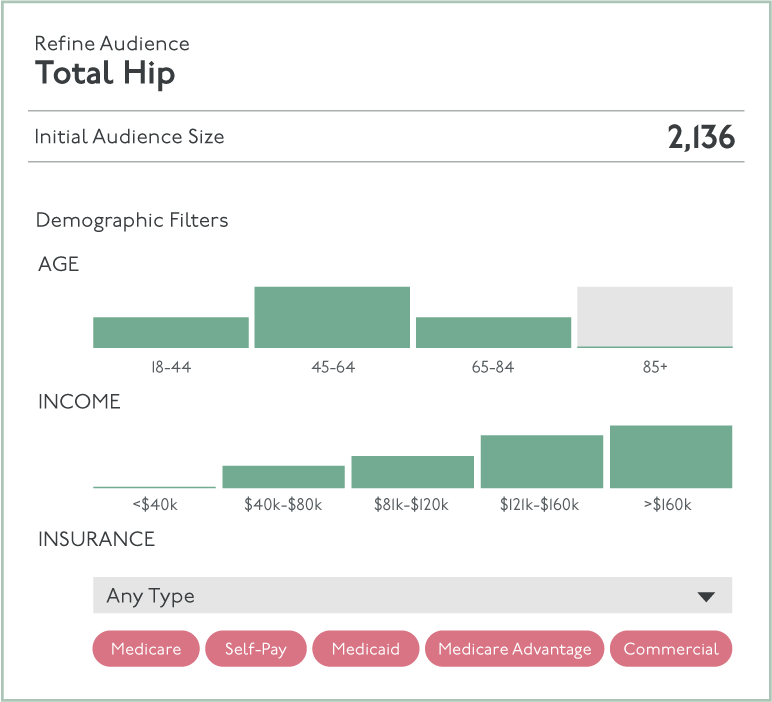Healthcare marketing has long been lagging behind the modern digital marketing landscape where data-driven precision targeting works wonders, delivering quick results and enviable advertising ROI.
The slow adoption of advanced marketing strategies in healthcare is mainly attributed to the strict requirements of HIPAA and Personal Health Information (PHI) protection. Understandably, these concerns have made healthcare providers shy away from using digital marketing to promote their businesses due to non-compliance fears; marketing professionals have found themselves boxed in by regulations that limit their ability to apply their deep knowledge and skills in the healthcare marketing context.
Today, the rise of healthcare marketing-oriented tools and innovative solutions allows healthcare marketers and providers to finally leverage data-driven marketing techniques while maintaining HIPAA compliance and ensuring PHI protection.
Among these new features, one stands out as particularly transformative: predictive targeting in healthcare. This approach revolutionizes how healthcare providers reach their target audiences. So let’s explore what predictive targeting is and how it works in the healthcare industry.
What Is Predictive Targeting in Healthcare?
 Predictive targeting in healthcare is an advertising practice that relies on machine learning and data points to discover and reach prospective patients in need of specific healthcare services with remarkable accuracy.
Predictive targeting in healthcare is an advertising practice that relies on machine learning and data points to discover and reach prospective patients in need of specific healthcare services with remarkable accuracy.
It allows you to reach and acquire high-value patients for the most profitable healthcare services. Precision in audience targeting helps you improve marketing efficacy, reduce marketing spend, increase marketing ROI, and optimize patient acquisition costs.
Healthcare providers who made predictive targeting part of their strategy have seen up to 2,500% return on their marketing investment. Did we pique your interest? Good.
How Is Predictive Targeting Reshaping Healthcare Marketing?
Predictive targeting addresses a critical challenge in healthcare marketing: the limited data access and usage in targeting high-value patients. The data limitations have put healthcare marketers at a disadvantage compared to other industries where extensive data is used to pinpoint audiences effectively.
Addressing The Limitations of Traditional Targeting
Traditional healthcare marketing often relies on basic demographic targeting—age, gender, zip codes—sourced from third-party vendors such as the Post Office. Healthcare providers and marketers send out vast numbers of postcards hoping to reach the right audience, but often with disappointing results. This approach is expensive and remarkably inefficient: it fails to engage the individuals who would benefit most from specific healthcare services and dismisses postcard marketing as a costly approach with low results, which isn’t necessarily the case.
Increasing Digital Advertising ROI
Surprisingly, the inefficiency persists on digital platforms like Facebook and Instagram, too. These platforms, despite having seemingly sophisticated audience filters, are truly designed to spend your money fast, making you increase your budget, often without seeing the exponential growth in the healthcare industry. Healthcare marketers find themselves in a cycle of spending without substantial returns, as the platforms’ algorithms prioritize quick consumption of advertising budgets over effective patient targeting.
Maximizing Data Potential in Healthcare Marketing
Predictive targeting transforms healthcare marketing by making precise patient targeting in healthcare possible. This method leverages existing data within the confines of HIPAA compliance to identify and engage with high-value patients in need of profitable services. By focusing on efficiency and relevance, predictive targeting helps grow healthcare businesses at scale.
This innovative approach is setting a new standard, moving away from the frustrating hit-and-miss tactics of the past and leading towards a future where healthcare marketing is as targeted and efficient as the best of digital marketing in other industries.
Behind The Scenes: How Does Predictive Targeting in Healthcare Work?
To make predictive targeting part of your healthcare marketing strategy, you’ll need a tool capable of predictive analysis. Not counting the magic ball and other supernatural predictive props, right now, the only HIPAA-compliant healthcare marketing platform that offers this possibility is SocialClimb.
Now, we’re not here to toot our own horn but instead to let you in on the innovation that’ll transform your healthcare business (or marketing agency) growth. Let’s talk about it.
But How Does It Find The Right People?
Predictive targeting in healthcare is rooted in analyzing vast amounts of data to identify patients most likely to need specific treatments. For example, examining data from the last 100,000 hip replacement patients helps create predictive models that leverage over 2,500 data points, including demographic information, technology usage, financial details, and online behaviors, which help significantly refine target audiences.
What’s The Role of AI and Machine Learning in Predictive Targeting in Healthcare?
The predictive targeting process is powered by artificial intelligence and machine learning, which sift through the data points to find commonalities and assign values to various audience attributes. Once these patterns are established, the predictive model is refined to exclude personally identifiable information (PHI), ensuring compliance with HIPAA privacy regulations.
How Can Healthcare Providers and Healthcare Marketers Use The Predictive Targeting Feature?
Now that we understand the technicalities behind predictive targeting in healthcare, let’s see how it applies to everyday healthcare marketing activities and how your marketing team can make the best use out of it.
Finding At-Risk Patients for Profitable Healthcare Services
The platform allows healthcare marketers to visualize and select their target audiences effectively.
Marketers begin by choosing the area in which they want to target patients. They then choose from a variety of healthcare service lines, such as orthopedics or mental health, and select a specific service within that category, for example, a knee surgery or hip replacement. Finally, they define the risk level of potential patients they want to target.

The system provides options to further refine the audience by excluding certain demographic groups, like the very elderly or those below a certain income level, ensuring that the marketing efforts are as efficient as possible.
After setting up all the filters, the platform will generate an audience list that is then used in ad campaigns.
Ad Placement
Once the audience is defined, the platform enables multi-channel advertising workflows. It supports the creation of trackable postcards and digital ads, primarily through Facebook and Instagram.
Efficient Postcard Marketing
You can create targeted and trackable postcards within the platform following a simple workflow. Use the template gallery or import your own design, and use tracking features to add call tracking and QR codes to your postcards so you can track your campaign performance. The postcards will then be sent straight to the audience list you previously created, and the reporting dashboard will regularly update you on your campaign performance.
Social Media Advertising
The platform’s integration with social media uses sophisticated algorithms to match the targeted ads with user profiles and yield repeated and focused engagement with potential patients, enhancing conversion rate and optimizing the advertising spend.
Handling Sensitive Information
The platform is designed to prioritize user privacy and comply with regulatory standards and, as such, operates with the highest degree of discretion. The deployment of audience lists and other marketing materials doesn’t disclose personal details—instead, it relies on aggregated data to maintain privacy. This data protection approach is essential for maintaining trust and complying with ethical marketing practices.
The platform’s ability to use comprehensive data for targeting while maintaining privacy through anonymization and data protection measures reflects the advanced level of modern healthcare marketing technologies. This ensures that healthcare providers and marketers can reach the right patients without compromising on ethical standards or privacy.
Predictive targeting in healthcare helps you find high-value patients while ensuring that these marketing efforts are respectful, precise, and effective.
Integrating Predictive Targeting with Healthcare Marketing Funnel
To get the most out of predictive targeting in healthcare, it’s crucial to understand how to integrate it with different healthcare marketing stages. Let’s take a look at how it fits into the three main stages: demand creation, demand capture, and patient conversion.
Demand Creation: Predictive Targeting at The Top of The Funnel
While marketing at the top of the healthcare marketing funnel, predictive targeting can significantly refine methods that rely on mass media.
While traditional media aims to build brand awareness broadly and social media helps personalize the approach and yield engagement, predictive targeting in demand creation focuses efforts on individuals who are statistically more likely to develop certain health conditions based on data analytics.
This targeted approach ensures that marketing efforts are more cost-effective and more likely to resonate with an audience that has a higher potential need for specific healthcare services, laying the grounds for successful patient acquisition.
Demand Capture: Predictive Targeting at Mid-Funnel
During the demand capture phase, where prospective patients actively seek healthcare, predictive targeting enhances the precision of digital marketing tools such as ads and social media campaigns.
By analyzing historical data and user behaviors, predictive models can increase the relevance of ads and content presented to the users, attracting patients who are more likely to convert based on their immediate needs and behaviors.
Patient Conversion: Predictive Targeting at The Bottom of The Funnel
Predictive targeting plays a crucial role in the conversion phase and provides accurate tracking and analysis of how marketing strategies lead to patient actions.
By understanding which attributes and behaviors correlate with higher conversion rates, healthcare marketers can optimize their campaigns to focus on the most promising leads. This reduces the patient acquisition cost and enhances the overall effectiveness of your marketing efforts, ensuring that resources are invested in strategies that yield the best ROI.
Enhanced Patient Engagement & Improved Patient Outcomes
Through predictive targeting, healthcare marketers can direct their efforts more effectively across all phases of the marketing funnel, focusing resources on prospective patients and ensuring that each touchpoint is optimized for engagement and conversion.
Ultimately, predictive targeting helps achieve better patient outcomes by ensuring that potential patients receive timely and relevant information about healthcare services that align closely with their conditions or health risks.
This proactive engagement facilitates early interventions and can lead to better health management, improving the quality of life for patients and enhancing their overall healthcare experience.
The Crucial Benefits of Predictive Targeting in Healthcare
Predictive targeting in healthcare is revolutionizing healthcare business growth and sustainability. Let’s remind ourselves (but mostly you because, trust us, we know) of the key benefits it brings you:
Higher Marketing ROI and Lower Patient Acquisition Cost
Predictive targeting optimizes marketing spend by attracting high-value patients and focusing on high-margin services, resulting in a higher return on investment (ROI) and lower the patient acquisition cost. This efficiency boosts profitability and enhances the financial sustainability of your healthcare business.
Enhanced Reporting and Conversion Tracking
Predictive targeting doesn’t stop at audience generation—it offers advanced reporting capabilities that allow healthcare marketers to track how and where patients are converting. This insight into patient journeys helps refine marketing strategies, improve engagement, and further lower acquisition costs.
Process Automation and Efficacy
Predictive targeting leverages automation to streamline the advertising process, making it both more effective and efficient. By automating complex data analysis, healthcare marketers can quickly identify and act on valuable opportunities and direct their time and resources toward high-value workflows without doing all the heavy lifting.
Predictive Targeting in Healthcare at Work: Examples and Results
Here’s how some of SocialClimb’s users leveraged predictive targeting in healthcare to their benefit and promoted their crucial services to grow their healthcare businesses.
DOC Earned over $500k from Knee Surgeries
Desert Orthopaedic Centers (DOC) in Las Vegas wanted to increase the number of patients seeking help with knee issues. Ideally, these patients would be commercially insured and need surgical intervention.
DOC used SocialClimb’s predictive targeting tool to identify and target 20k individuals in the Las Vegas area who were predicted to need knee replacement or related surgical interventions through personalized postcard marketing.
The practice spent $37k on this campaign, and within six months, it yielded 272 new patients—a 1.36% conversion rate—6x higher than the national average.
Most of these patients became surgical cases, bringing the expected collectible revenue to $1.2 million. The campaign’s return on investment (ROI) was more than 3,191% .
OrthoSouth Gained 209 High-Value Patients in 4 Months
OrthoSouth in Memphis, Tennessee, sought to increase the practice’s visibility and attract patients in the competitor-dominated areas. They ran three campaigns using SocialClimb’s patient targeting tool and personalized postcards to community members predicted to have hip, knee, and spine issues.
The practice spent $18.1k to identify three unique audiences and send around 8,700 personalized postcards to these potential patients. Over four months, OrthoSouth gained 218 new patients from this campaign with a 2.5% conversion rate—12x higher than the national average.
Again, most of these patients needed significant surgical interventions, yielding high patient value and a total revenue of $326,500, making the return on investment (ROI) 1,801% .
Yield High ROI on Healthcare Marketing with Predictive Targeting
![]() Predictive targeting is transforming healthcare marketing by enhancing the precision and effectiveness of every phase within the marketing funnel—from demand generation to patient conversion.
Predictive targeting is transforming healthcare marketing by enhancing the precision and effectiveness of every phase within the marketing funnel—from demand generation to patient conversion.
By leveraging HIPAA-compliant data analytics, healthcare providers can focus their marketing efforts on individuals who are most likely to need specific services, improve the overall efficiency of marketing campaigns, increase the healthcare marketing ROI, streamline the process of patient acquisition, and grow their healthcare business at a scale.
Moreover, predictive targeting in healthcare significantly contributes to improved patient outcomes by enabling timely medical attention.
Ultimately, the integration of predictive targeting into healthcare marketing strategies redefines how providers connect with and serve their communities. It promises better marketing metrics and a more proactive and patient-centered approach to providing healthcare.
SocialClimb’s comprehensive healthcare marketing platform is the only one on the market to offer the innovative, HIPAA-compliant predictive targeting tool—and it helps you seamlessly integrate it into your healthcare marketing process with a wide array of supporting tools and features. From reputation management and local SEO to automated patient surveys and comprehensive KPI reporting, this platform offers everything you need to conduct seamless healthcare marketing campaigns at high efficiency and optimized cost.
So, the only question that remains really is—what will your marketing ROI be six months from now?











